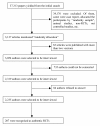Randomized trials published in some Chinese journals: how many are randomized?
- PMID: 19573242
- PMCID: PMC2716312
- DOI: 10.1186/1745-6215-10-46
Randomized trials published in some Chinese journals: how many are randomized?
Abstract
Background: The approximately 1100 medical journals now active in China are publishing a rapidly increasing number of research reports, including many studies identified by their authors as randomized controlled trials. It has been noticed that these reports mostly present positive results, and their quality and authenticity have consequently been called into question. We investigated the adequacy of randomization of clinical trials published in recent years in China to determine how many of them met acceptable standards for allocating participants to treatment groups.
Methods: The China National Knowledge Infrastructure electronic database was searched for reports of randomized controlled trials on 20 common diseases published from January 1994 to June 2005. From this sample, a subset of trials that appeared to have used randomization methods was selected. Twenty-one investigators trained in the relevant knowledge, communication skills and quality control issues interviewed the original authors of these trials about the participant randomization methods and related quality-control features of their trials.
Results: From an initial sample of 37,313 articles identified in the China National Knowledge Infrastructure database, we found 3137 apparent randomized controlled trials. Of these, 1452 were studies of conventional medicine (published in 411 journals) and 1685 were studies of traditional Chinese medicine (published in 352 journals). Interviews with the authors of 2235 of these reports revealed that only 207 studies adhered to accepted methodology for randomization and could on those grounds be deemed authentic randomized controlled trials (6.8%, 95% confidence interval 5.9-7.7). There was no statistically significant difference in the rate of authenticity between randomized controlled trials of traditional interventions and those of conventional interventions. Randomized controlled trials conducted at hospitals affiliated to medical universities were more likely to be authentic than trials conducted at level 3 and level 2 hospitals (relative risk 1.58, 95% confidence interval 1.18-2.13, and relative risk 14.42, 95% confidence interval 9.40-22.10, respectively). The likelihood of authenticity was higher in level 3 hospitals than in level 2 hospitals (relative risk 9.32, 95% confidence interval 5.83-14.89). All randomized controlled trials of pre-market drug clinical trial were authentic by our criteria. Of the trials conducted at university-affiliated hospitals, 56.3% were authentic (95% confidence interval 32.0-81.0).
Conclusion: Most reports of randomized controlled trials published in some Chinese journals lacked an adequate description of randomization. Similarly, most so called 'randomized controlled trials' were not real randomized controlled trials owing to a lack of adequate understanding on the part of the authors of rigorous clinical trial design. All randomized controlled trials of pre-market drug clinical trial included in this research were authentic. Randomized controlled trials conducted by authors in high level hospitals, especially in hospitals affiliated to medical universities had a higher rate of authenticity. That so many non-randomized controlled trials were published as randomized controlled trials reflected the fact that peer review needs to be improved and a good practice guide for peer review including how to identify the authenticity of the study urgently needs to be developed.
Figures
Comment in
-
Pharmacological treatments for generalised anxiety disorder.Lancet. 2019 Oct 5;394(10205):1229. doi: 10.1016/S0140-6736(19)31409-6. Lancet. 2019. PMID: 31591980 No abstract available.
References
-
- Gu R, Shi YY, Wu TX, Liu GJ, Zhang MM. Chinese medicinal herbs for measles. Cochrane Database Syst Rev. 2006;19:CD005531. - PubMed
-
- Higgins JPT, Green S, Eds Cochrane Handbook for Systematic Reviews of Interventions 4.2.5 http://www.cochrane.org/resources/handbook/ [Updated May 2005]. (Accessed 19 December 2005).
Publication types
MeSH terms
LinkOut - more resources
Full Text Sources
Miscellaneous



